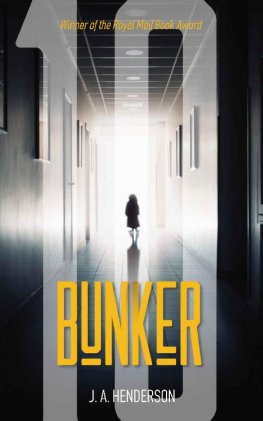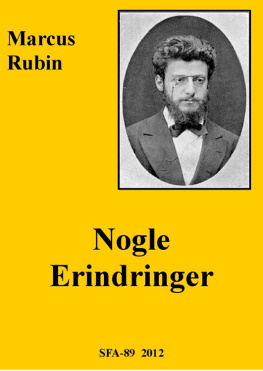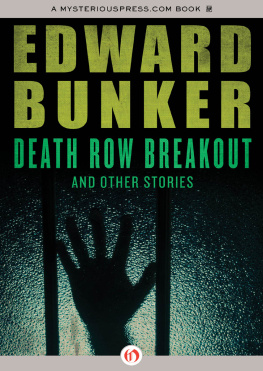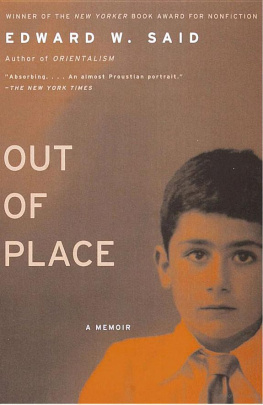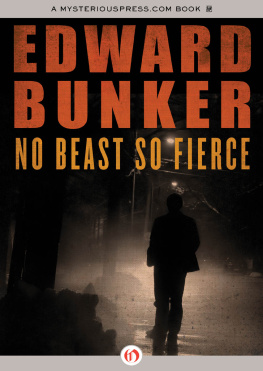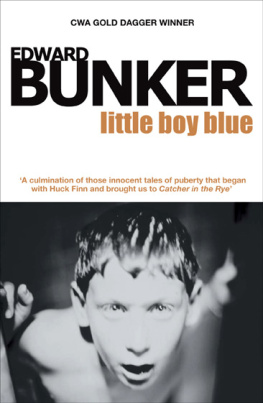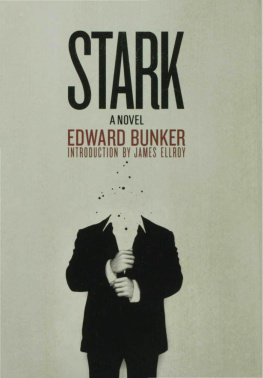Praise for Edward Bunker and his previous books
Bunker is a true original of American letters.
James Ellroy
Bunker is among the tiny band of American prisoner writers whose work possesses integrity, craftsmanship, and moral passion.
William Styron
Bunker shoots straighthis direct and transparent prose captures the primacy of violence that defines life in the slammer... Bunker clearly articulates the code of prison life and the pathology of the career criminal in raw, muscular prose.
Kirkus Reviews
Bunker writes about the netherworld of societys outcasts with a passion and insight that comes from having lived life close to the bone.
The Los Angeles Times
The best first-person crime novel Ive ever read.
Quentin Tarantino on No Beast So Fierce
The best armed robbery novel ever written.
James Ellroy on Dog Eat Dog
A scalding experienceand a literary triumph in the tradition of Dreiser, Farrell, and James Jones. This is an important book.
Roderick Thorp, author of Nothing
Lasts Forever, on Little Boy Blue
EDUCATION OF A FELON

| ALSO BY EDWARD BUNKER The Animal Factory No Beast So Fierce Dog Eat Dog Little Boy Blue |
EDUCATION OF A FELON. Copyright 2000 by Edward Bunker. All rights reserved. Printed in the United States of America. No part of this book may be used or reproduced in any manner whatsoever without written permission except in the case of brief quotations embodied in critical articles or reviews. For information, address St. Martins Press, 175 Fifth Avenue, New York, N.Y. 10010.
Design by Judith Stagnitto Abbate/Abbate Design
www.stmartins.com
Library of Congress Cataloging-in-Publication Data
Bunker. Edward.
Education of a felon : a memoir / Edward
Bunker ; introduction by William Styron
p. cm.
ISBN 0-312-25315-X (he : alk. paper)
ISBN 0-312-28076-9 (pbk)
1. Bunker, Edward. 2. Criminals
CaliforniaBiography. 3. Prisoners
CaliforniaBiography. I. Title.
HV6248.B773 A3 2000
364.1'092dc21
[B]
99-055061
CIP
D 10 9 8
This ones for my son. I waited many years so I could deal him a better hand than I had. Im sure hell play his cards better than I played mine. e.b.
CONTENTS
INTRODUCTION
E DWARD B UNKER IS one of a small handful of American writers who have created authentic literature out of their experiences as criminals and prisoners. Now sixty-five years old, Bunker has been out of prison since 1975, but before that time he spent nearly all of the years of his life, except those of his earliest childhood, behind bars. That is to say, until his early forties Bunker was far better acquainted with incarceration as a way of life than he was with even limited freedom. That this career, so practically devoid of any of the normal inducements toward education and self-realization, could have produced writing of any kind is most unusual; that it yielded not only No Beast So Fierce but three other novels of genuine literary achievement (so far) is astonishing, placing Edward Bunker among the tiny band of American prisoner-writers whose work possesses integrity, craftsmanship, and moral passion in sufficient measure to claim our serious attention. In order to understand the nature of Bunkers extraordinary accomplishments, it is necessary to recount some of the details of his life, which was one of deprivation and violence, indeed, an existence so close to nihilismat least in the mind of the bourgeois readeras to make almost totally implausible any idea of creativity or the eventual blossoming of a literary career.
Bunker was born and reared in, of all places, Hollywood, California. Unlike the majority of American criminals, he was born white. His father was a stagehand in legitimate theaters around Los Angeles and occasionally found employment in the movie studioshe once worked for the Hal Roach organization during the filming of the famous Our Gang comedies. His mother was a professional dancer and performed as a chorus girl in Busby Berkeley movies. Alcoholism drove Bunkers father into a state hospital and the couple was divorced when Eddie was four. Exacerbated by the hard times of the Great Depression, the boys life followed the pattern of so many others that are the product of alcoholism and broken families. He was in and out of foster homes and military schools, from which he began to run away with determination augmented by an obstinate antiauthoritarian streak well developed even at that early age. At eleven he was committed briefly to Camarillo State Hospital for observation, and a year later he was sent to the juvenile reform school at Whittier. He made his escape, and when caught was sent to a much tougher school designed for unruly boys four or five years older. Here he spent a year or so and at fourteen was paroled. Twenty-nine days into freedom he was caught trying to rob a liquor store and was shot (though not seriously wounded) by the owner. This crime gained Bunker a sentence to the youth prison at Lancaster, even though he was considerably younger than the legally mandated age of eighteen to twenty-five. Throughout this period, Bunker was consistently thrown into an environment with older criminals. After having stabbed a guard at Lancaster, he was taken to the Los Angeles County Jail, where at fifteen he was placed in the tank reserved for notorious cases. His companions included several murderers awaiting the death penalty. Because of his age, and because his lawyer, the celebrated Al Matthews, who took the case pro bono, was able to show that correctional officers had abused Bunker on prior occasions, the judge deemed him too young for San Quentin and gave him a county jail sentence with probation. Proceedings were suspended. He was set free.
It was while he was briefly at large that Eddie was befriended by Mrs. Hal Wallis, wife of the renowned film producer (Casablanca, Becket, and many others) and herself a onetime comedienne in Mack Sennetts Keystone Comedies. Louise Fazenda Wallis made efforts to steer Eddie in the direction of probity and worthiness, but her concern came to naught. His friends, except for Louise Wallis, were reform school graduates and confirmed professional criminals. Bunker, now sixteen, began selling marijuana and was enthusiastically engaged in boosting (professional shoplifting) and learning to play short con games such as The Match, The Strap, and Laying the Note. He was delivering some marijuana when a pair of detectives flagged him down. A wild chase ensued through Los Angeles streets; the automobile he was driving caromed off three cars and hit a mail truck head-on before he was captured. The judge was still unwilling to send a sixteen-year-old to San Quentin and gave him a year in the county jail and more probation. He promptly escaped.
At this point Bunkers luck ran out. Rather, the calendar said he was seventeenstill not eighteen, but old enough. For the escape and the assault on the Lancaster guard, he was sentenced to two concurrent six-month-to-ten-year terms, and he was sent to San Quentin.
It was during the four-and-a-half-year stay at San Quentin that Bunker discovered books and began to read and write. Louise Wallis sent him a Royal portable typewriter and a subscription to the
Next page

